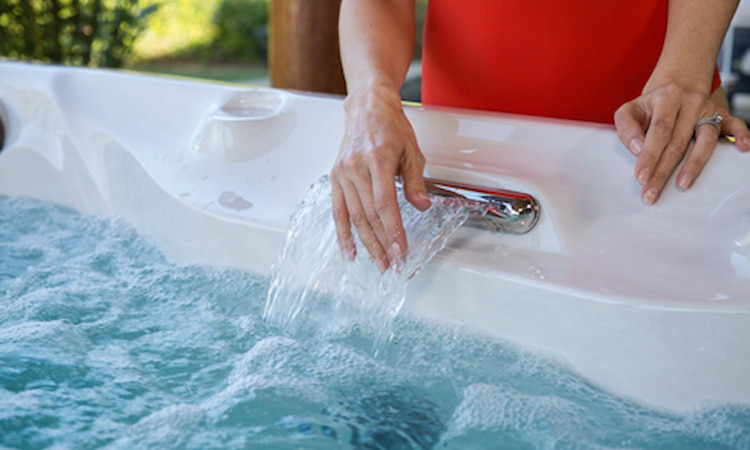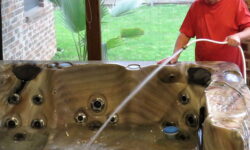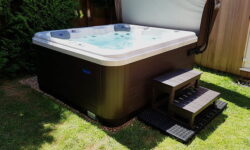You’re wondering if you can fill your hot tub with well water. It’s a valid question, and you’re not alone.
Yes, you can fill a hot tub with well water. However, well water often contains high levels of minerals and other impurities that can affect the quality of your hot tub water. These impurities may cause damage to the hot tub’s components over time. Therefore, it’s recommended to test and treat well water before using it in a hot tub.
We’ll guide you through the basics, alert you to potential hazards, and give you expert advice on how to maintain your well-water-filled hot tub.

Quick Navigation
Understanding the Basics of Well Water
Essentially, well water is water drawn directly from groundwater in the Earth via a well. Wells are dug or drilled deep into the ground to tap into aquifers – permeable rocks that can contain or transmit groundwater.
Unlike city water, which is treated and monitored by local municipalities, well water’s quality and safety depend on many factors. These include the condition of your well, the soil surrounding it, and your region’s specific geology.
Well water can contain a variety of minerals and contaminants. Common ones include iron, manganese, and calcium, which are generally harmless but can affect water’s taste and hardness.
More problematic are potentially harmful substances like bacteria, viruses, nitrates, and heavy metals. For these reasons, you may need to test and treat well water before using it, especially in a hot tub where warm temperatures can foster bacteria growth.
The Impact of Well Water on Hot Tub Components
While you might not think it, the minerals and contaminants in well water can have a significant impact on your hot tub’s components, and it’s crucial to understand these effects before you decide to fill up.
High mineral content, particularly calcium and magnesium, can cause scale buildup on your tub’s internal components, affecting its efficiency and lifespan. Over time, this buildup can lead to blockages in your tub’s pipes, filter, and heater, leading to costly repairs.
Moreover, the presence of iron and manganese can stain your tub’s surface, giving it a discolored and unattractive appearance. Metals can also corrode various components, including the heater element, jets, and pump seals, reducing their functionality over time.
Related Read: What Color Should Hot Tub Water Be?
Furthermore, well water often contains bacteria and other microorganisms that can pose health risks if not properly treated. These can lead to the development of biofilm in your tub’s plumbing system, which can be difficult to remove and can cause major problems down the line.
Health Implications of Using Well Water in Hot Tubs

There are several potential health implications you’ll need to consider if you’re planning to use well water in your hot tub.
Well water can contain a variety of bacteria and other microorganisms that can be harmful to your health. Additionally, the minerals present in well water can react with the heat of the hot tub, potentially creating harmful chemicals.
Here are four key health implications to consider:
- Bacterial Infections: Well water is not treated and can harbor bacteria, leading to skin, ear, and other infections. Regular testing and disinfection are crucial.
- Mineral Reactions: High mineral content in well water, when heated, can produce harmful chemicals. This can cause skin irritations and respiratory problems.
- Waterborne Diseases: Well water can contain harmful pathogens, such as Giardia or E.coli, which can lead to waterborne diseases.
- Allergic Reactions: Some individuals may have allergic reactions to the minerals present in well water.
Necessary Precautions When Using Well Water
Before diving in, it’s important to consider at least six necessary precautions when using well water to fill your hot tub.
Firstly, you must test the well water for bacteria, nitrates, and pH levels. High levels of these components can pose health risks.
Secondly, remember to check for heavy metals. If your well water contains lead, arsenic, or other heavy metals, avoid using it in your hot tub.
Thirdly, it’s essential to understand that well water often contains minerals like iron and calcium. These minerals can accumulate in your tub, causing damage over time. A pre-filter can be used to reduce mineral content before it enters the tub.
The fourth precaution is to monitor your tub’s water regularly. Changes in water color, clarity, or smell can indicate issues with your well water.
Fifthly, ensure your hot tub’s filtration and sanitization systems are functioning optimally. These systems are crucial in maintaining the water’s cleanliness.
Lastly, consider seeking professional advice if you’re unsure about the safety of your well water. Experts can provide definitive tests and recommend appropriate actions. Following these precautions can help ensure a safe and enjoyable hot tub experience.
Related Read: How to Change Hot Tub Water? A Complete Guide
Expert Tips for Maintaining a Well-Water-Filled Hot Tub
You’ve filled your hot tub with well water, now let’s discuss some expert tips to help you keep it clean and safe. It’s crucial to maintain the water quality and protect your hot tub components.
Here are four key steps to follow:
- Test Water Regularly: Use a reliable testing kit to monitor your water’s pH, alkalinity, and sanitizer levels. Adjust them as necessary to maintain balanced water.
- Shock Your Hot Tub: Especially if your well water is high in minerals, shocking your hot tub can help keep the water clean and clear. Do this regularly, following the instructions on your chosen shock product.
- Clean the Filters: Over time, your hot tub’s filters will capture debris and minerals from the well water. Clean them regularly to ensure they work effectively and don’t wear out prematurely.
- Drain and Refill Periodically: Even with regular upkeep, it’s a good idea to drain and refill your hot tub every three to four months. This will help prevent buildup of minerals and bacteria that could affect water quality.
Frequently Asked Questions
You’ll generally find it cheaper to fill your hot tub with well water, as you’re not paying for city water. However, consider potential treatment costs for hard water and contaminants often found in well water.
Yes, well water can affect the color and clarity of your hot tub water. It often contains minerals like iron and manganese that can discolor water. It’s best to test your well water before using it.
Yes, certain hot tub models have robust filtration systems that handle well water better. It’s crucial you research each model’s specifications and consult with the manufacturer for optimal well water compatibility.
You can visually inspect your well water. If it’s clear and odorless, it’s likely suitable. However, for a thorough check, testing for pH levels, hardness, metals, and bacteria at home is recommended.
Yes, utilizing well water in your hot tub could impact its warranty. It’s essential to check your warranty’s specifics, as some manufacturers may void it if damages occur from incorrect water use.
Conclusion
In essence, you can fill your hot tub with well water, but be mindful of potential impacts on the hot tub’s components and your health. Ensure you take the necessary precautions and regularly maintain your hot tub for a safe and enjoyable experience.
Always consult with experts if you’re unsure. Remember, well water isn’t a bad choice, but it requires a bit more attention to detail. Keep your hot tub clean and safe, no matter the water source.






![Can You Put a Hot Tub on Pavers? [Pros & Cons] can you put your hot tub on pavers](https://hottubtales.com/wp-content/uploads/2023/10/can-you-put-your-hot-tub-on-pavers-250x150.jpg)